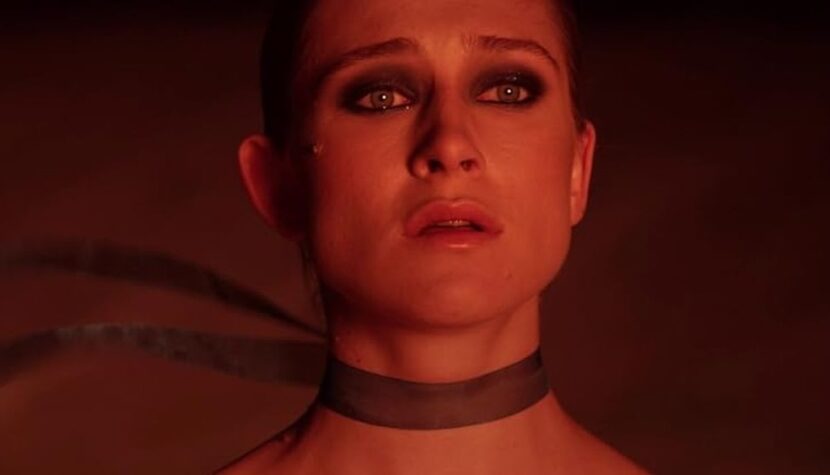VANISHING WAVES. Science fiction in the spirit of Tarkovsky and Nolan

First associations with Lithuania? The Polish-Lithuanian Commonwealth, the invocation from Pan Tadeusz, the Gates of Dawn in Vilnius, the Niemen River, kindziuk and kołduny (traditional Lithuanian dishes), but probably not science fiction films. Meanwhile, our northeastern neighbors handle this genre much better than we do.
Young scientist Lukas participates in a groundbreaking research experiment involving the connection of his brain with the mind of an anonymous patient submerged in a coma. The aim of the project is to study and observe the brain activity of individuals with profound consciousness disorders. Lukas receives strict instructions not to make contact with the patient during the connection and not to interfere in any way with the experiment, limiting himself to observation. The first attempt fails, but during the second, Lukas enters a hyperrealistic world of a young woman’s imagination, whom he rescues from drowning. During the next session, a passionate act of love takes place between them. The scientist conceals this fact from the research team but feels an increasing need to meet with the woman “on the other side.” He also discovers that the anonymous patient is a young girl named Aurora, a victim of a car accident. Lukas becomes obsessed with her, risking the experiment’s failure and neglecting his wife. Meanwhile, a mysterious man appears in Aurora’s mind.

Screenwriter, director, and producer Kristina Buožytė is a graduate of the Lithuanian Academy of Music and Theatre in Vilnius. During her studies, she created several short and documentary films, participated in various film workshops, and worked as an editor. A turning point in her career was her feature-length debut and diploma film, The Collectress (2008), a story about a traumatized woman who stages and records emotional situations on video because she believes it will unlock her suppressed feelings. The Collectress was featured in the repertoire of many international film festivals (including Karlovy Vary, Valencia, São Paulo, Cairo, and Meinheim) and received eight nominations for the Lithuanian Film Award; ultimately, it won two Silver Cranes for Best Film and Best Actor (Marius Jampolskis). More importantly, the success of the film enabled Buožytė to secure funding for her next project: an original screenplay co-written with Brunonas Samperis. Vanishing Waves marks the first science fiction production in the history of Lithuanian cinema.
In an interview with “Electric Sheep” magazine, the creator stated that Vanishing Waves touches on the psychological aspects of human relationships: emotions, attitudes, love, desire, suffering, and pleasure. To this list, one can add epistemological, ontological, and ethical issues because the film also addresses the limits of human understanding, the essence of existence, and the moral boundaries of scientific experiments. Buožytė and Samperis avoid tedious didacticism or annoying pseudo-philosophical rambling—on the contrary, their film is surprisingly subtle and balanced in the realm of ideas and words. Indeed, there isn’t much of the latter here, allowing the creators to avoid shovelware, literalness, and quasi-scientific explanations of the technical details of the mind-linking process (attempts in films almost always end in absurd, embarrassing discussions that have little to do with current knowledge). Moreover, the plot—Lukas and Aurora’s tragic love story—is captivating and emotionally engaging, with an unpredictable finale.

However, the most impressive element of Vanishing Waves is its visual side. Sequences taking place in the world of dreams, subconsciousness, and hallucinations are reminiscent of Solaris (1972) by Andrei Tarkovsky, Altered States (1980) by Ken Russell, The Cell (2000) by Tarsem Singh, and Inception (2010) by Christopher Nolan—and undoubtedly, Buožytė studied the aesthetics of these films diligently but managed to avoid imitation. The hypnotic, stunning images filling Vanishing Waves linger with the viewer long after the screening ends: underwater drowning, a spectral beach, “alien” food on a lavishly set table, a strange insect laying eggs, a black hole pulsating against a blood-red sky where the sun should be, a psychodelic orgy reminiscent of the parties in Eyes Wide Shut (1999) by Stanley Kubrick, a wooden house eternally “frozen” in decay like devastated architecture in the paintings of Monsù Desiderio (a collective pseudonym for 17th-century painters François de Nomé and Didier Barra)—Why aren’t such films made in Poland? That’s the million-dollar question.

